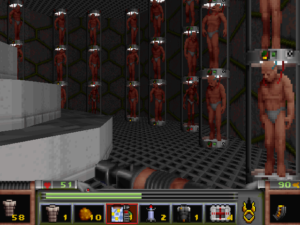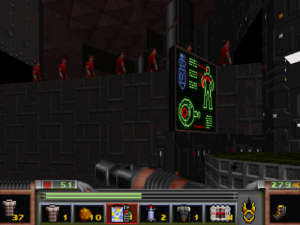Strife: Cyborgs and Zombies
 Between Strife and Etherlords and Half-Life 2, I’ve been seeing a lot of cyborgs lately. Like zombies, they seem to be one of the stock videogame bad guys. I suppose this means that a lot of people find them emotionally resonant or something, evoking alienation from one’s body, enhanced by fear of mortality in the case of zombies, and of technology overpowering humanity in the case of cyborgs. Both, in different ways, represent anxieties about the future.
Between Strife and Etherlords and Half-Life 2, I’ve been seeing a lot of cyborgs lately. Like zombies, they seem to be one of the stock videogame bad guys. I suppose this means that a lot of people find them emotionally resonant or something, evoking alienation from one’s body, enhanced by fear of mortality in the case of zombies, and of technology overpowering humanity in the case of cyborgs. Both, in different ways, represent anxieties about the future.
Although I understand these fears well enough to name them, I’ve never really felt them, and often find zombies in games more irritating than frightening. I suspect this is because I haven’t watched the right movies. (Imagine playing Jedi Knight without having seen any of the Star Wars films.) But I get that zombies are convenient low-level enemies, with a built-in rationale for being stupid and slow-moving, and you can shoot them without qualms because they’re incapable of reason and not really human. Cyborgs have the same basic advantages, but with the additional virtue that the basic idea allows for more variation. A ten-foot-tall zombie, or one with a scorpion’s tail, would be an anomaly requiring explanation.
I didn’t intend at first to talk about zombies in this post, because I’m supposed to be posting about Strife, and there aren’t any zombies in Strife. But cyborgs and zombies are really variations on the same theme, and the distinction between the two has blurred somewhat since things like Resident Evil started giving us zombies with technological origins. If the people in that game had been transformed into monsters by nanomachines instead of a virus, which would they be? Doom put it concisely when it refused to hang its low-level grunts on either peg, calling them just “former humans” in the manual.
 There’s one thing about the cyborgs in Strife that really reminded me of zombies, though, and that’s because it reminded me of a phenomenon I’ve mainly seen in survival-horror games. There’s always a moment near the beginning of those games where the characters have their first encounter with a monster and someone says something like “My god… what is that thing?” To which the player naturally responds “IT IS A ZOMBIE, DUH.” 1Notable exception: when I played Silent Hill 2 (the first of the Silent Hill games I played), my reaction was more like “…I honestly have no idea.” Sometimes I think the designers must be doing this on purpose, trying to engage the player in a Rocky Horror-like call-and-response. Well, when you reach the inner sanctum of the Conversion Chapel and see captive humans being fed into a cybernizing machine on a conveyor belt, Blackbird 2Your contact in the Front, who comminucates with you by radio and apparently sees everything you see. She functions as a combination quest dispenser and wisecracking sidekick, and provides the closest thing this game has to a PC voice. At first I wondered if hearing Blackbird’s disembodied voice wherever you go was supposed to parallel the “voices” heard by the founders of the Order, but it doesn’t look intentional. Those voices aren’t really part of the game content, and may well have been thought up only when they needed some backstory to fill out the opening spiel. is shocked — shocked! — at what she sees, as if we hadn’t gone in there specifically looking for it . Maybe it’s just the intonation that makes me interpret it this way, but this is the game’s “duh” moment.
There’s one thing about the cyborgs in Strife that really reminded me of zombies, though, and that’s because it reminded me of a phenomenon I’ve mainly seen in survival-horror games. There’s always a moment near the beginning of those games where the characters have their first encounter with a monster and someone says something like “My god… what is that thing?” To which the player naturally responds “IT IS A ZOMBIE, DUH.” 1Notable exception: when I played Silent Hill 2 (the first of the Silent Hill games I played), my reaction was more like “…I honestly have no idea.” Sometimes I think the designers must be doing this on purpose, trying to engage the player in a Rocky Horror-like call-and-response. Well, when you reach the inner sanctum of the Conversion Chapel and see captive humans being fed into a cybernizing machine on a conveyor belt, Blackbird 2Your contact in the Front, who comminucates with you by radio and apparently sees everything you see. She functions as a combination quest dispenser and wisecracking sidekick, and provides the closest thing this game has to a PC voice. At first I wondered if hearing Blackbird’s disembodied voice wherever you go was supposed to parallel the “voices” heard by the founders of the Order, but it doesn’t look intentional. Those voices aren’t really part of the game content, and may well have been thought up only when they needed some backstory to fill out the opening spiel. is shocked — shocked! — at what she sees, as if we hadn’t gone in there specifically looking for it . Maybe it’s just the intonation that makes me interpret it this way, but this is the game’s “duh” moment.
| ↑1 | Notable exception: when I played Silent Hill 2 (the first of the Silent Hill games I played), my reaction was more like “…I honestly have no idea.” |
|---|---|
| ↑2 | Your contact in the Front, who comminucates with you by radio and apparently sees everything you see. She functions as a combination quest dispenser and wisecracking sidekick, and provides the closest thing this game has to a PC voice. At first I wondered if hearing Blackbird’s disembodied voice wherever you go was supposed to parallel the “voices” heard by the founders of the Order, but it doesn’t look intentional. Those voices aren’t really part of the game content, and may well have been thought up only when they needed some backstory to fill out the opening spiel. |
 Comments(2)
Comments(2)
I totally feel your pain when developers lean on well tread sci-fi conventions, and then play them off the main characters as if no one ever saw the movie, “Alien”. Their world is sometimes easily identifiable as the same one we live in, yet it must be different because no one can seem to comment on how totally clichéd the story is…
Sometimes developers will turn on this for a good, if cheap laugh if the narrative will allow a little humor. For a game that makes the majority of it’s hay on this, and does an amazing job of it, check out Broken Helix. I had it for Playstation, but I think it had a PC release too. It stars Bruce Campbell to hilarious effect.
Zombiewise – there are some decent zombie movies out there. In particular I’d recommend the original Dawn of the Dead, 28 Days Later (not “zombies”, technically, but whatever), Shaun of the Dead, and probably a few others that I’m spacing on right now. The new Dawn of the Dead not so much, although it has the benefit of having a lounge version of Disturbed’s “Down With the Sickness” on the soundtrack. Hilarity ensues.
Still, while I heartily recommend watching these movies, none of them have made me all that interested in zombies themselves. The zombies are just kind of an environmental hazard and plot device for themes I find more interesting like post-apocalyptic survival. For genuinely interesting zombies, you need to turn to books. In particular, Brian Keene’s “The Rising”, “City of the Dead”, and “Dead Sea”, also Max Brooks’ excellent pseudo-historical “interview” collection, World War Z.